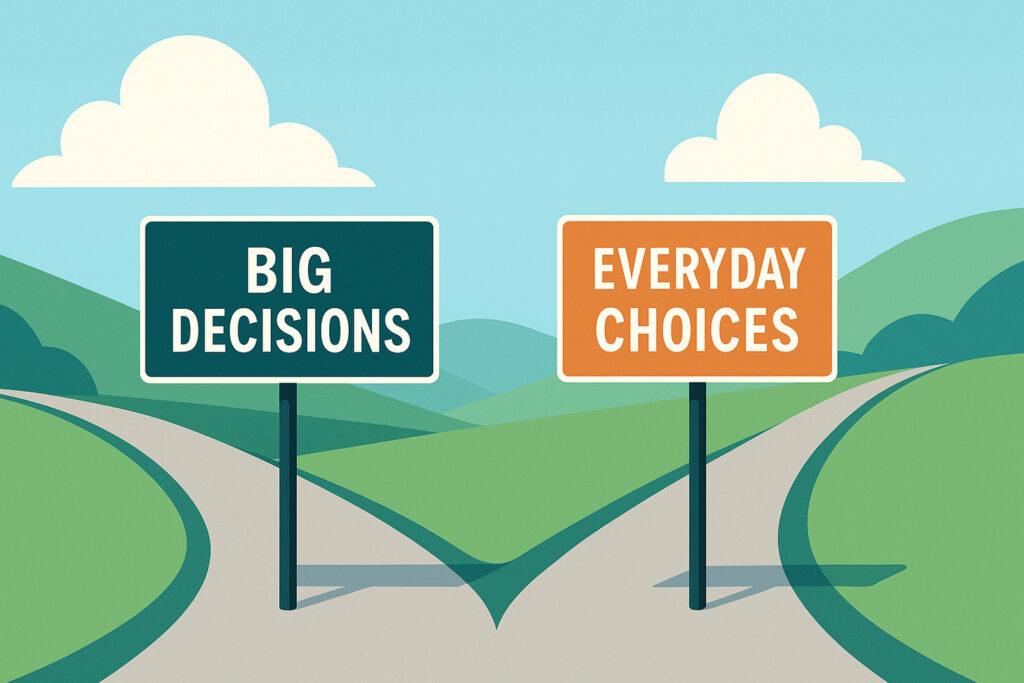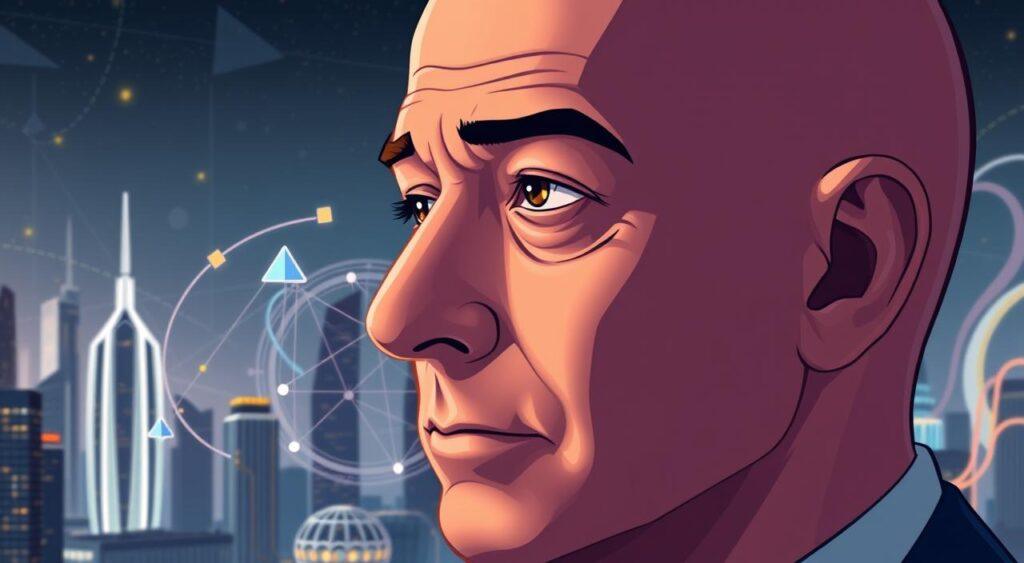Imagine you’re at a big crossroads in your life or career. You’re unsure about jobs, relationships, or big financial risks. The Regret Minimization Mental Model, popularized by Jeff Bezos, offers a solution. It asks you to think about this: “Which decision will I regret not making when I’m 80?”
This approach uses insights from behavioral economics, decision theory, and emotional intelligence. It guides you to make choices that won’t lead to regret later. It’s about focusing on what truly adds value to your life.
Think of it as a compass for life’s toughest calls. Unlike methods that prioritize instant rewards, this framework focuses on reducing future emotional pain. It’s why leaders like Jeff Bezos credit it for bold career moves—it turns “what if” fears into clarity.
You already use mental models daily without realizing it. They’re like invisible lenses shaping how you solve problems. What makes this one unique? It forces you to project forward, using imagined hindsight to spotlight what truly matters.
Key Takeaways
- The regret minimization mental model shifts focus from immediate gains to long-term fulfillment
- Reduces overthinking by clarifying core values
- Used by successful entrepreneurs for high-stakes decisions
- Transforms vague worries into actionable insights
- Requires intentional practice for maximum impact
By the end of this guide, you’ll know how to apply this decision-making superpower to relationships, career pivots, and personal growth. Ready to make choices your future self will thank you for?
Introduction to the Regret Minimization Mental Model
In 1994, a simple question changed Jeff Bezos’ life—and could change yours too. While working at a top New York finance firm, he faced a choice: stay comfortable or chase an untested idea. His boss advised taking two days to reflect. What happened next became a blueprint for bold decision-making.
The Role of Emotional Forecasting
Emotional forecasting is key in this model. It helps us guess how we’ll feel later. Research shows we often think we’ll regret short-term failures more than we do. At the same time, we underestimate the pain of chances we miss.
This mental model uses this knowledge to cut down on emotional bias. It doesn’t focus on quick comfort. Instead, it makes choices that match our core values and what we imagine our future happiness to be.
Concept Overview and Long-Term Thinking
Bezos didn’t compare salaries or job titles. He asked, “Will 80-year-old me wish I’d tried this?” This shift from immediate costs to lifetime fulfillment cuts through hesitation. It turns “someday” thinking into today’s action plan.
Most frameworks focus on pros and cons. This one asks you to become your own future advisor. By visualizing decades ahead, temporary fears shrink. What remains? The stakes that truly matter.
Jeff Bezos’ 1994 Breakthrough
Leaving mid-year meant losing his bonus. The internet was uncharted territory. But Bezos realized something profound: inaction often hurts more than failure. His “what if” became a $1.7 trillion company.
This approach works because it uses time as a lens. Short-term stress fades. Long-term pride—or disappointment—sticks. Whether changing careers or relationships, the question stays the same: Which path leads to peace?
How would your choices shift if you consulted the 80-year-old version of yourself?
The Core Principles Behind the Model

Why do people often look back wishing they’d taken more risks? Science shows our brains prioritize avoiding short-term pain, even when it costs long-term fulfillment. The most transformative choices require understanding what truly sticks with us over decades.
Why Future Regret Matters
A 2013 Cornell study tracked 370 adults for 18 years. Researchers found 84% of lasting regrets stemmed from paths not taken—unspoken feelings, careers not pursued, adventures delayed. Failed attempts caused temporary pain. Missed chances left permanent “what if” echoes.
Palliative nurse Bronnie Ware documented similar patterns in 2012. Her patients’ top regret? “I wish I’d had the courage to live true to myself.” Over half died with dreams untouched, not because they failed, but because they never tried.
Insights from the Cornell Study on Inaction Regrets
Two factors make inaction haunt us:
1. Uncertainty magnification: We imagine better outcomes for untested choices
2. Identity erosion: Repeatedly avoiding risks reshapes how we see ourselves
This framework works because it confronts our bias for safety. By asking “What will 80-year-old me cherish?” you sidestep temporary fears. You’re not predicting emotions—you’re aligning choices with who you want to become.
Does your current decision process honor your future self’s peace of mind?
Regret Aversion in Behavioral Economics
Behavioral economists call it regret aversion bias. This is when we avoid actions that might cause future regret. Even if not acting is riskier.
This pattern often leads to the very outcome we feared. It’s ironic.
The Regret Minimization Model changes this. It tells us to act despite uncertainty. Not trying is often the most painful outcome long-term.
Using the regret minimization mental model for Career, Relationships, and Personal Growth
At 45, Maria faced a crossroads: stay in her secure accounting job or launch the bakery she’d dreamed of since college. Her choice wasn’t about cupcakes versus spreadsheets—it was about aligning actions with her 80-year-old self’s peace of mind. This approach works beyond career shifts, helping people navigate love, learning, and leaps of faith.
Career Crossroads Made Clear
Consider this table comparing two paths for someone debating starting a business versus staying employed:
| Factor | Staying Employed | Launching Business |
|---|---|---|
| 5-Year Stability | Predictable income | Variable cash flow |
| 20-Year Fulfillment | Possible promotions | Legacy creation |
| Regret Potential | “What if I’d tried?” | “At least I risked it” |
Maria realized her corporate role offered safety but drained her creativity. She now runs a thriving bakery—and sleeps better knowing she honored her younger self’s passion.
Love, Growth, and Hard Choices
This method also clarifies relationship decisions. Should you move cities for a partner? Commit despite doubts? Ask: “Which choice lets me respect myself decades from now?”
For personal growth, it pushes past “someday” thinking. A 52-year-old teacher used it to finally get her pilot’s license. His logic? “Crashing would hurt less than never flying.”
What dream have you sidelined that your future self wishes you’d pursued?
Making Bolder, Values-Driven Choices

What if your future self could guide your current decisions? This question fuels the regret minimization framework, turning vague anxieties into clear action plans. By envisioning your 80th birthday, you cut through momentary fears to uncover what truly deserves your energy.
Projecting Yourself at 80 to Clarify Priorities
Jeff Bezos famously asked: “Will I wish I’d done this when I’m 80?” His answer launched Amazon. This approach separates fleeting worries from lasting concerns. Short-term setbacks fade. Untapped potential lingers.
A teacher once shared how this method changed her life. She left a stable job to write novels, reasoning: “My older self would care more about stories told than pensions earned.” Five years later, her third book hit bestseller lists.
The framework works because it:
- Exposes choices driven by others’ expectations
- Highlights paths aligned with personal goals
- Reduces “someday” thinking to concrete steps
Bezos clarified his decision by distinguishing fear of failure from fear of inaction. “Not trying would haunt me more than any bankruptcy,” he realized. This mindset turns risks into respected experiments rather than paralyzing threats.
How might your next big choice shift if you consulted the wisest version of yourself?
Real-Life Use Cases in Therapy and Coaching
Therapists use future-self visualization to help clients with decision paralysis. Career coaches have clients journal from their 80-year-old self’s point of view. These methods make long-term thinking more real.
This technique helps build emotional resilience. It changes how we see present risks. It views them as investments in our growth and being true to ourselves.
Reducing Analysis Paralysis with a Future-Focused Approach
Decision fatigue creeps in when every choice feels monumental. The regret minimization framework acts like a spotlight, cutting through the fog of “what ifs” by asking one radical question: “When I’m 80, will I wish I’d tried this?”
This method transforms endless pros-and-cons lists into clear action. Instead of predicting outcomes, you measure choices against your future peace of mind. Bezos captured it perfectly: “Not trying would haunt me daily—making the decision simple.”
Overcoming Short-Term Fears
Immediate worries—like embarrassment or temporary setbacks—loom large in the moment. But visualize your 80-year-old self reflecting on today. Would they care about this month’s awkward conversation… or decades of unexplored potential?
A marketing director once agonized over leaving her stable job. Using this approach, she realized: “My older self would regret playing small more than any career stumble.” She launched her consultancy three weeks later.
Regret Minimization Mental Model: Embracing Decision Simplicity
Complex choices become straightforward when filtered through time. Ask:
- Does this align with who I want to become?
- Will inaction create more “what ifs”?
- Which path lets me respect my courage later?
This framework removes the need for perfect predictions. Focus shifts from “Will this work?” to “Can I live with not trying?” The answer often surprises people—and moves them forward.
What decision have you been circling that needs this clarity?
When Not to Use the Regret Minimization Mental Model

The regret minimization model is very strong, but it’s not perfect for every choice. It can make small, everyday decisions feel too heavy. For example, deciding which gym to go to or which software to use.
Those who often worry or can’t stop thinking about things might find this model too much. It can make their fears seem bigger than they are. For them, using the Eisenhower Matrix mental model or Opportunity Cost might be better.
Case Studies and Real-Life Examples

New York City traffic screeched to a halt as Jeff Bezos scribbled his business plan in a rental car. It was 1994. The “world wide web” grew 2300% annually—a really big deal most bankers dismissed. His former boss called it a “gold rush for nerds.” Bezos saw something deeper: a chance to build the company his future self would admire.
How Jeff Bezos Transformed His Life and Business
Leaving Wall Street meant sacrificing a six-figure bonus. Colleagues warned about the investment risk. But Bezos kept asking: “Will I regret not trying this thing called internet commerce?” His now-famous newsletter to friends outlined a vision for online bookselling—the seed that became Amazon.
Key drivers behind his choice:
- Seeing web growth as irreversible, not speculative
- Prioritizing legacy over short-term security
- Accepting failure as preferable to lifelong “what ifs”
Personal Reflections on Life-Changing Decisions
A Colorado teacher used the same approach to launch a vineyard at 58. “I knew if I failed, I’d recover. But not trying? That would haunt me,” she shared. Her small-batch wines now supply 12 local restaurants.
An investor client applied it to portfolio choices: “I ask if each startup aligns with the world I want at 80.” This filter helped him back three unicorn companies in renewable energy tech.
What bold move have you been postponing that your future self wishes you’d pursue today?
Conclusion
What story will your 80-year-old self want to tell? The Regret Minimization Mental Model helps you make big, meaningful choices. It changes your focus from quick wins to lasting happiness.
It’s not about being perfect—it’s about being true to yourself. Making choices that match your future self’s values helps you avoid regrets. You’ll avoid missing out on dreams and playing it too safe.
Whether you’re starting a business, moving to a new place, or speaking your mind, this model guides you. It makes tough choices easier, keeps you focused, and helps you use your time wisely.
Your next decision might seem small now, but it could be huge later. What choice can you make today that your 80-year-old self will be proud of?


